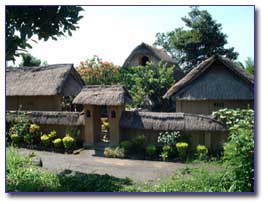|
 Architecture Architecture
Balinese
temples are divided into three parts. One inevitably passes
through a split gate or Candi Bentar to enter the first courtyard.
Then a second gate rising high with the grinning face of a
guardian demon leads to the second division. Inside there
are numerous pavilions used for various purposes. In the final
courtyard one may find the meru pagoda which may have as many
as eleven roofs if the owner or temple is important enough.
The black thatch is from the sugar palm and can only be used
in temples. There will also be numerous sanggah or spirit
houses, and pedestals which will be full of offerings on ritual
days. All around you, carving in brick, volcanic stone and
wood will be apparent. All are ringed by walls. The Balinese
have always spent a great deal of energy and money on their
temples for it is their duty to repay the ancestors for their
prosperity.
Balinese
royalty has always felt it imperative that they demonstrate
their prosperity and standing by building magnificent palaces.
The carved wooden doors of these palaces are especially famous
for their beauty. The teak doors of the main palace of Denpasar
were so large that they required forty porters to carry them.
In the palaces bright colours and gold leaf abound for the
display of opulence and even the smallest and most insignificant
of details is deemed proof of nobility. Unlike Europe, Balinese
palaces are not single huge buildings but rather a collection
of numerous structures each with a special function such as
the bale gede, an open pavilion of 12 columns, where the oldest
male of the family sleeps. During important ceremonies such
as tooth filing, this will serve as a place to commune with
the ancestors and gods who descend from the heavens to partake
of the many offerings placed on the beds. As in the temples,
the four directions of the Balinese compass are critical in
determining the lay-out and positioning of buildings.
Another large and important structure is the wantilan or cock
fighting arena. It is called this because at one time cock-fights
were frequently held here. It is found near the palace and
central market in every traditional village. Nearby stands
a kulkul or slit drum tower to call the members of the village
together for meetings. The wantilan is also commonly used
for performances. Once built entirely of wood, most are made
of re-enforced concrete today. The traditional wantilan has
also inspired the shapes and forms of many hotels and houses,
such as the Amandari.
By
using such natural materials as thatch roofing, bamboo poles,
woven bamboo, coconut wood, mud and stone, complete harmony
with the environment is maintained. The Balinese have always
been particularly adept at using bamboo and behind every Balinese
house one can find at least one stand of bamboo.
The introduction of cement and other modern materials and
the rapid growth of hotels, galleries and new homes has produced
mixed results. The opulence and ornamentation of many new
hotels are often breath-taking. Nowhere else in the world
would such wood carvings and stone work be possible. Still
the line between kitsch and good taste is narrow and too often
people have failed to appreciate the essence of Balinese architecture
that in many cases has become an amazing parody of itself.
One hopes that in the future more attention will be paid to
resorts like the Amandari and Four Seasons Resort in Jimbaran,
who have modified traditional Balinese architecture without
tainting its integrity.
For
those truly interested in Balinese architecture, a visit to
the Bali Museum in Denpasar is a must. There you will not
only find many old traditional buildings but also information
as to the local styles, of which there are many.
|



